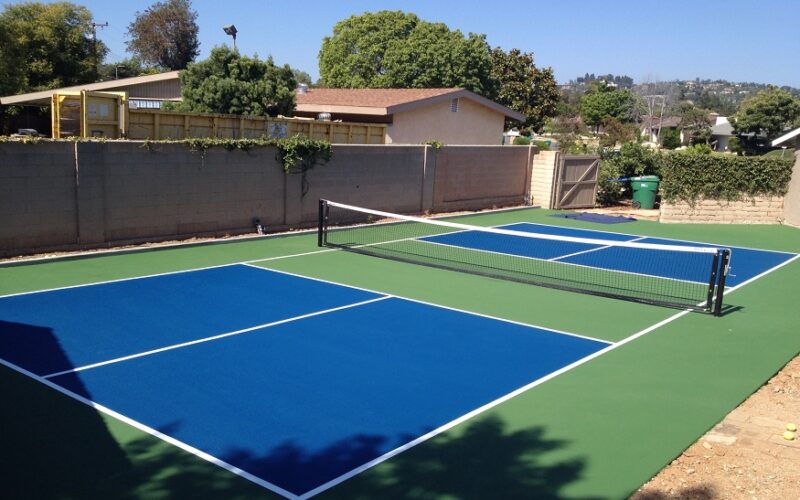Explore the importance of choosing the best color for pickleball lines on your tennis court. Understand the impact of different colors on visibility, aesthetics, and gameplay. Discover popular color choices, their pros and cons, and maintenance best practices to keep your court vibrant.
Pickleball has surged in popularity, and the details matter, including the color of the lines on your tennis court. This guide delves into the significance of selecting the best color for pickleball lines, exploring factors influencing the choice, popular color options, their pros and cons, maintenance practices, and the potential impact of color on the player experience.
Importance of Pickleball Court Line Color
Enhancing Visibility and Aesthetics
The color of pickleball lines is not merely aesthetic; it plays a crucial role in enhancing visibility during gameplay. Vibrant lines not only contribute to the overall court aesthetics but also ensure players can track the ball’s movement accurately.
Impact on Gameplay
The color of the lines can impact gameplay by influencing how players perceive the court. Properly visible lines contribute to fair play, preventing disputes and creating an enjoyable experience for all skill levels.
Read more: Cash, Strategy, and Victory: The Rise of Real Money Ludo Gaming Platforms
Factors Influencing the Best Color Choice
Court Surface Material
The material of the court surface influences how colors appear. Whether your court is made of asphalt, concrete, or another material, considering how colors interact with it is essential.
Surrounding Environment
The surrounding environment, including the color of the tennis court itself, landscaping, and nearby structures, should be taken into account. A harmonious color scheme can enhance the overall visual appeal.
Player Preferences
Understanding the preferences of the players who frequent the court is paramount. Some players may find certain colors more visually appealing or easier to track during a match.
Popular Color Choices for Pickleball Lines
Traditional White
White lines are a classic choice, offering a clean and timeless look. They are suitable for various court surfaces and blend well with most environments.
High-Visibility Yellow
Yellow lines provide excellent visibility, especially against darker court surfaces. They are a popular choice for ensuring players can easily distinguish the boundaries.
Contrasting Colors
Using colors that contrast with the court surface can create a dynamic visual effect. This can aid in visibility and add a unique touch to the court.
Pros and Cons of Different Color Choices
White Lines
Pros: Classic and timeless, suitable for most environments.
Cons: May not provide optimal visibility on lighter court surfaces.
Yellow Lines
Pros: High visibility, especially on darker surfaces.
Cons: May clash with certain court colors, potentially affecting aesthetics.
Contrasting Colors
Pros: Dynamic and visually striking.
Cons: Impact on aesthetics, and may not suit all environments.
Best Practices for Maintenance of Pickleball Lines
Regular Cleaning
Regularly cleaning the lines with mild detergents helps maintain their vibrancy and visibility. Avoiding abrasive materials is crucial to prevent premature wear.
Surface Repainting
Periodic surface repainting is essential to keep the lines crisp and visible. The frequency depends on factors like usage intensity and weather conditions.
Addressing Wear and Tear
Promptly addressing any wear and tear, such as fading or chipping, is crucial. Timely maintenance ensures the lines remain in top condition.
Impact of Color on Player Experience
Psychological Effects
Colors can have psychological effects on players, influencing their mood and mindset during a match. Harmonious color choices contribute to a positive playing environment.
Potential Performance Enhancement
While not a guarantee, certain colors might contribute to improved player performance. Enhanced visibility and a visually pleasing court can positively impact the player experience.
FAQs
How does line color impact gameplay?
Line color impacts gameplay by influencing how players perceive the court boundaries, preventing disputes and creating a fair playing field.
Can I change the color of existing pickleball lines?
Yes, changing the color of existing lines is possible through surface repainting. Professional assistance is recommended for optimal results.
Are contrasting colors suitable for all environments?
Contrasting colors can be visually striking but may not suit all environments. Consider the overall aesthetic and player preferences.
What maintenance is required for different color lines?
Regular cleaning, periodic repainting, and prompt addressing of wear and tear are essential maintenance practices for all color lines.
Does line color affect the lifespan of the court surface?
Line color itself doesn’t significantly affect the court surface lifespan. However, proper maintenance of lines contributes to the overall longevity of the court.
How often should pickleball lines be repainted?
The frequency of repainting depends on factors like usage intensity, weather conditions, and court surface material. As a general guideline, lines may need repainting every 1-3 years.
Conclusion
Choosing the best color for pickleball lines is a thoughtful process that considers visibility, aesthetics, and player preferences. Whether you opt for classic white, high-visibility yellow, or contrasting colors, maintaining these lines enhances the overall appeal of your tennis court. Elevate your pickleball experience with vibrant, well-maintained lines that contribute to fair play and a positive playing environment.

